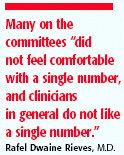FDA panels fail to set target levels for renal patients' hemoglobin
Advisory committees to the FDA recently declined to recommend any set target or range for hemoglobin levels for patients taking ESAs to combat anemia associated with chronic renal failure.

The FDA had asked the committees if ESA labels should be changed to state that the target hemoglobin should not be more than approximately 11 gm/dl for patients on hemodialysis. That was the level associated with better survival in the "Normal Hematocrit" study done in the 1990s. The agency also asked whether 11 gm/dl should be the target for chronic renal failure patients not on dialysis, because in the CHOIR (Correction of hemoglobin and outcomes in renal insufficiency) study, which ended in 2005, that level was associated with fewer adverse cardiovascular events.

With millions of dollars in ESA reimbursements at issue, the joint meeting of the Cardiovascular & Renal Drugs and the Drug Safety & Risk Management Advisory Committees was held recently, with more than 200 people in attendance. According to the Government Accountability Office, the ESA epoetin alfa (Epogen, Amgen; Procrit, Ortho Biotech) accounted for $2 billion in Medicare payments in 2005 and is the highest Part B expenditure drug.
Rafel Dwaine Rieves, M.D., acting director, FDA Division of Medical Imaging & Hematology Products, noted there had been a range of opinion on the committees. Some thought the level should be 11; others thought 11 to 12, or another variation. He said it was plain that many on the committees "did not feel comfortable with a single number, and clinicians in general do not like a single number. They like a range." He said he thought FDA decision-makers would take that to heart.
John Jenkins, M.D., director of the Office of New Drugs in FDA's Center for Drug Evaluation & Research, said FDA officials hope to decide on the labeling changes for both the oncology and the renal indications for ESAs within "weeks, not months."
Quality of life
FDA officials also believe they will be able to make statements on quality-of-life issues. Several physicians and patients argue that the higher hemoglobin levels allow many patients to lead a normal life.
Rieves said he heard a consensus in the discussion on the importance of identifying and managing ESA hyporesponders, for both current practice and future study. Analyses of both random control trials suggested that patients with the lowest hemoglobin response to an ESA dose are most at risk of serious cardiovascular events.
Jenkins cautioned, however, that "for labeling claims, we require substantial evidence, which is very different from clinical practice observations that patients may appear to have felt better in response to therapy.... It's not as if we are throwing out and disregarding the issue of quality of life."
THE AUTHOR is a writer based in the Washington, D.C., area.